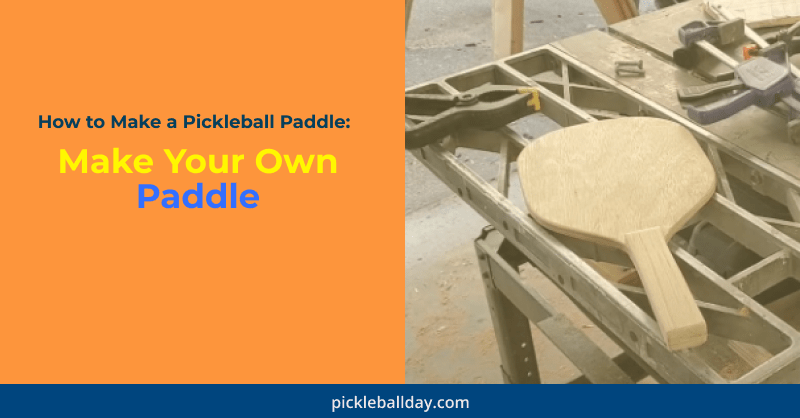The sports industry is growing rapidly, with equipment and rules changing exponentially. That said, the pickleball paddle manufacturing industry is inventing new technologies. Ignore the wooden paddles back in high school. There are evolved versions with different sizes and shapes, which expands the chances of choosing the right pickleball paddle from endless possible variations.
Many players, even veterans, don’t understand how a pickleball paddle is made and its differences. Neither do they know the materials used nor the basic construction. Knowing your equipment makes you confident in your game, hence better performance as a pickleball player.
Table of Contents
- 1 How Was the First Pickleball Paddle Made?
- 2 What are Pickleball Paddles materials?
- 3 How Many Types of Materials are Used in Pickleball Paddles?
- 4 Pickleball Paddle’s Core Materials
- 5 Pickleball Paddle’s Surface materials
- 6 Assembling Handles and Graphics
- 7 Assembling Rims and Caps
- 8 How long my DIY pickleball paddle last?
- 9 How to Take Care of DIY Pickleball Paddle
- 10 FAQs
- 11 Final Wraps
How Was the First Pickleball Paddle Made?
Have you ever wondered how the wooden pickleball paddle evolved into the modern lighter paddle? Arlen Paronto made the first lightweight paddle in 1984.
Since his son, Steve Paronto, was a pickleball champion, Arlen got inspired to create the best equipment to make the boy perform better. So he took advantage of the scrap materials from his garage and invented the first composite pickleball paddle.
Later, when the sport became popular, Arlen made 1,000 paddles from graphite, honeycomb, and fiberglass. He later sold his company to Frank Candelario. In 1990, it was the next big thing, being used in all 50 states.
What are Pickleball Paddles materials?
Pickleball paddles are made of composite materials, graphite, and wood. The latter is the cheapest and most traditional option. The drawback is that they are relatively heavier than the other materials. That means it is not the right option if you want to play for an extended period.
The graphite pickleball paddle is the most expensive of the three. However, they are lighter and perfect for playing for long periods, unlike wooden paddles. Composite paddles stand in the middle ground. They are better than wooden paddles, but not as much as graphite paddles.
How Many Types of Materials are Used in Pickleball Paddles?
The question remains about how pickleball paddles are made. The paddle’s body entails two types of materials – the core and the surface.
- The Core: This is the thick layer that makes up the base of the paddle. Its depth can be sixteen millimeters. Thanks to the Boeing Industrial Engineer, Arlen Paronto, all core materials come with a honeycomb design.
- The Surface: The surface is the covering that protects the core. It covers both sides and is designed with special attributes that prevent damage to the core.
Pickleball Paddle’s Core Materials
A good pickleball paddle depends on its core material. It contributes to the power and control you get when playing. A paddle’s core comes in Nomex, aluminum, or polypropylene.
- Nomex: Pickleball paddles are among the many Nomex tech applications. The process entails a cardboard-like material coated with resin and constructed like a honeycomb. It results in a dense, durable pickleball paddle with perfect control. It makes loud noises, though.
- Aluminum: While aluminum pickleball paddles are lightweight, they have the best control. They have less power than Nomex paddles, though. However, it is the most common choice among pickleball players.
- Polypropylene: On the other hand, polypropylene is the newest technology in the pickleball industry. It has good tension to produce great power when playing. Since they are quieter and softer than the other materials, they have become the most popular paddles in the current market.
Pickleball Paddle’s Surface materials
Core and surface materials are combined to give performances that match the preferred game and style. There are five pickleball paddle surface materials: fiberglass, graphite, carbon fiber, aluminum, and plastic.
- Fiberglass: The fiberglass surface paddle was made using the latest aerospace technology. They have incredible strength, feel, and increased playability. It also offers more power than most surface materials.
- Graphite: Paddle surfaces made of graphite are thin and light. They serve as the hardest and strongest surface materials. It is stiff and, hence, good for ball placement.
- Carbon Fiber: One of the most durable, expensive, softest, and lightest materials used for paddle surfaces is carbon fiber. It is merged with a honeycomb core to give a distinctive appearance with high tech. It has great control but less power compared to other surface materials.
- Aluminum: Aluminum surfaces have a soft feel and great control. Its lightweight and density contribute to less power. Usually, a paddle with an aluminum core has a surface made of the same material.
Assembling Handles and Graphics
A paddle’s head needs heavy equipment to manufacture. However, making a pickleball paddle is quite easy. If you are the DIY type, these assembling steps will ensure you don’t purchase a new one.
- Decide the Design: I bet you already know the two main types of design for paddles. If you are looking for a standard-sized paddle, you have to go for a 16 x 8-inch paddle. Or, if you are a player who wants more reach on the court, aim for the elongated-shaped paddle of 17 x 7 inches.
- Create a Template: You can draw a paddle on paper with the desired measurements, like a 16-inch length and an 8-inch width. It helps you determine the accurate height and weight of your paddle.
- Decide the Material: Wood and plywood are common DYI materials. Modern materials include aluminum, graphite, fiberglass, honeycomb, and Nomex, which are expensive and rare.
- Cut the Template: After choosing the accurate measurements, cut out the template and glue it on the wooden paddle. Ensure it is properly attached.
- Sand to Smooth: Sand the paddle’s surface until it gets smoother.
- Customize Your Paddle: Choose your favorite color, sticker, and graphic to customize your paddle.
- Assemble the handle: Glue wood pieces or foam to one side of the handle. Then, wrap it with your preferred tennis grip. Finally, apply electric tape at the top and bottom of the grip to make it more elegant. You can choose a small grip to enhance control or a large one for stability.
Assembling Rims and Caps
After assembling the handle and graphics, it’s time to install the rim and cap on your new paddle.
- Install the Rim: Attach the rims to the edges of the paddle head (paddles’ sides with a honeycomb design) to fix the paddle and protect the core. This edge guard also prevents the paddle from cracking when you drop it off.
- Fix the Cap: Glue the cap at the handle’s bottom, which is especially helpful if you are a beginner. It has a larger circumference than the handle, giving a good grip.
- Grip: After fixing the cap, wrap the handle with a rubber grip to make it more comfortable. It has a smooth finish and excellent traction to prevent the paddles from slipping out.
- Test: It’s time to rule the courts with your new paddle.
How long my DIY pickleball paddle last?
It’s always better to choose the standard pickleball paddle. Manufacturers sell them after making lots of research, innovation, and investment. So the qualities of the paddle available on market will always be better than a DIY paddle. And because of the materials used in those commercial paddles, they usually last for 2 to 3 years.
Your homemade paddle might not last long for 6 months or last even ten years. However, the durability always depends on the handling and playing frequency, plus taking care is vital as always.
How to Take Care of DIY Pickleball Paddle
Taking care of the pickleball paddle includes cleaning the handle and heads after each game. And storing them inside a paddle cover while not using. Plus, never keep anything on them, that will leave permanent scratches harming their spinning ability.
FAQs
Q1: Can I make Pickleball Paddle at home?
Q2: Which are the cheapest pickleball paddles made in the USA?
Q3: Where are pickleball paddles manufactured?
Q4: Which pickleball paddles are being made in the USA?
Q5: How much does it cost to make a pickleball paddle?
Q6: What is the best pickleball paddle brand?
Final Wraps
Pickleball paddles are continuously evolving as manufacturers keep on including better technologies. Engage with quality materials that boost your power and control as you test other specialized paddles.


